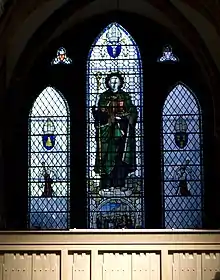HMS D2
HMS D2 was one of eight D-class submarine built for the Royal Navy during the first decade of the 20th century.
 HMS D2 | |
| History | |
|---|---|
| Name: | HMS D2 |
| Builder: | Vickers Armstrong, Barrow-in-Furness |
| Laid down: | 10 July 1909 |
| Launched: | 25 May 1910 |
| Commissioned: | 29 March 1911 |
| Fate: | Sunk, 25 November 1914 |
| General characteristics | |
| Class and type: | D-class submarine |
| Displacement: |
|
| Length: | 163 ft (50 m) (o/a) |
| Beam: | 13.6 ft (4.1 m) (o/a) |
| Installed power: |
|
| Propulsion: |
|
| Speed: |
Surfaced: 14 kn (16 mph; 26 km/h) Submerged: 10 kn (12 mph; 19 km/h) (design); 9 kn (10 mph; 17 km/h) (service) |
| Range: |
|
| Complement: | 25 |
| Armament: | 3 × 18 inch (450 mm) torpedo tubes (2 forward, 1 stern) |
Description
The D-class submarines were designed as improved and enlarged versions of the preceding C class, with diesel engines replacing the dangerous petrol engines used earlier. D2 was slightly smaller than her sister ships and had a length of 162 feet 1 inch (49.4 m) overall, a beam of 20 feet 6 inches (6.2 m) and a mean draught of 10 feet 10 inches (3.3 m). She displaced 489 long tons (497 t) on the surface and 603 long tons (613 t) submerged.[1] The D-class submarines had a crew of 25 officers and other ranks and were the first to adopt saddle tanks.[2]
For surface running, the boats were powered by two 600-brake-horsepower (447 kW) diesels, each driving one propeller shaft. When submerged each propeller was driven by a 275-horsepower (205 kW) electric motor. They could reach 14 knots (26 km/h; 16 mph) on the surface and 9 knots (17 km/h; 10 mph) underwater. On the surface, the D class had a range of 2,500 nautical miles (4,600 km; 2,900 mi) at 10 knots (19 km/h; 12 mph).[2]
The boats were armed with three 18-inch (45 cm) torpedo tubes, two in the bow and one in the stern. They carried one reload for each tube, a total of six torpedoes.[2]
Construction and career
D2 was laid down by Vickers on 10 July 1909 at their Barrow shipyard and commissioned on 29 March 1911. During her career, D2 returned from the second Heligoland Bight patrol along with D3, E5 and E7. On 28 August 1914, D2, D3 and D8 fought in the Battle of Heligoland Bight. Then, two days before D2 met her fate, Lieutenant Commander Jameson was washed overboard off Harwich. Lt. Cdr. Head was his replacement. D2 was rammed and sunk by a German patrol boat off Borkum on 25 November 1914, leaving no survivors.
Coplestone Memoraial Window, Chester

The Coplestone Memorial Window in Chester Cathedral is in memory of "F. Lewis Coplestone, Lt-Commander, Royal Navy, HM Submarine D2" and Commander A.F. Coplesone-Boughey, RN, HMS Defence.[3] It depicts St Anselm, Archbishop of Canterbury and shows at the bottom three coats of arms of the Coplestone family, which originated at the manor of Copleston in Devon.
Notes
- Harrison, Chapter 4
- Gardiner & Gray, p. 87
- https://www.warmemorialsonline.org.uk/memorial/239055/
References
- Akermann, Paul (2002). Encyclopaedia of British Submarines 1901–1955 (reprint of the 1989 ed.). Penzance, Cornwall: Periscope Publishing. ISBN 1-904381-05-7.
- Colledge, J. J.; Warlow, Ben (2006) [1969]. Ships of the Royal Navy: The Complete Record of all Fighting Ships of the Royal Navy (Rev. ed.). London: Chatham Publishing. ISBN 978-1-86176-281-8.
- Gardiner, Robert; Gray, Randal, eds. (1985). Conway's All the World's Fighting Ships: 1906–1921. Annapolis, Maryland: Naval Institute Press. ISBN 0-85177-245-5.
- Harrison, A. N. (January 1979). "The Development of HM Submarines From Holland No. 1 (1901) to Porpoise (1930) (BR3043)". Submariners Association: Barrow in Furness Branch. Archived from the original on 19 May 2015. Retrieved 19 August 2015.
